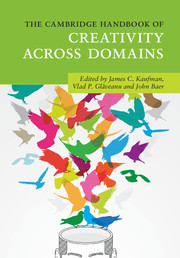Book contents
- The Cambridge Handbook of Creativity Across Domains
- The Cambridge Handbook of Creativity Across Domains
- Copyright page
- Dedication
- Contents
- Figures
- Tables
- Contributors
- Acknowledgments
- Part I Creativity and Domain
- Part II Creativity in the Traditional Arts
- Part III Creativity in the Sciences
- Part IV Creativity in Business
- 18 Studying Creativity across Different Domains
- 19 The Relationship Between Marketing and Creativity
- 20 Creative Leadership
- 21 Creativity in Business and Technology
- 22 Creativity in Design
- 23 A Minimalist Model for Measuring Entrepreneurial Creativity
- Part V Newer Domains for Creativity Research
- Part VI Creativity in Everyday Life
- Part VII Conclusion
- Index
- References
22 - Creativity in Design
from Part IV - Creativity in Business
Published online by Cambridge University Press: 15 September 2017
- The Cambridge Handbook of Creativity Across Domains
- The Cambridge Handbook of Creativity Across Domains
- Copyright page
- Dedication
- Contents
- Figures
- Tables
- Contributors
- Acknowledgments
- Part I Creativity and Domain
- Part II Creativity in the Traditional Arts
- Part III Creativity in the Sciences
- Part IV Creativity in Business
- 18 Studying Creativity across Different Domains
- 19 The Relationship Between Marketing and Creativity
- 20 Creative Leadership
- 21 Creativity in Business and Technology
- 22 Creativity in Design
- 23 A Minimalist Model for Measuring Entrepreneurial Creativity
- Part V Newer Domains for Creativity Research
- Part VI Creativity in Everyday Life
- Part VII Conclusion
- Index
- References
Summary
This chapter aims at characterizing creativity in design and, thus, creativity that occurs in an area in which there is an increasing need for innovations in our society. Indeed, designers have to satisfy the demand for new products that differ from existing ones. To help designers come up with new ideas leading to new products, it is necessary both to understand the creative process that underlays design activities and to determine appropriate ways to support it. To contribute to these goals, first, we characterize creativity in design and present descriptive models of both creativity and design processes. Then, we describe series of studies that focused on creativity in design, and we discuss ways of assessing creativity in design areas. Finally, we suggest potential orientations for future research in this domain and, especially, methods and computational systems to support creativity in design.
- Type
- Chapter
- Information
- The Cambridge Handbook of Creativity across Domains , pp. 403 - 427Publisher: Cambridge University PressPrint publication year: 2017
References
- 7
- Cited by

